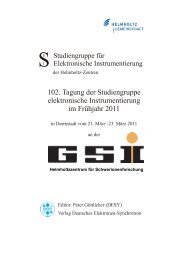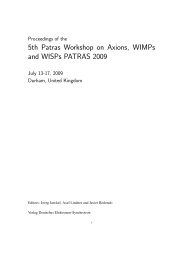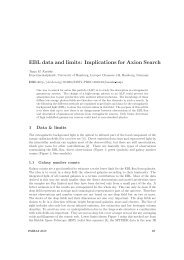Hamburg Neutrinos from Supernova Explosions ... - DESY Library
Hamburg Neutrinos from Supernova Explosions ... - DESY Library
Hamburg Neutrinos from Supernova Explosions ... - DESY Library
Create successful ePaper yourself
Turn your PDF publications into a flip-book with our unique Google optimized e-Paper software.
Long-term evolution of massive star explosions<br />
T. Fischer 1,2 , M. Liebendörfer 3 , F.-K. Thielemann 3 , G. Martínez-Pinedo 2,1 , B. Ziebarth 1 and<br />
K. Langanke 1,2,4<br />
1 GSI Helmholtzzentrum für Schwerionenforschung, Planckstraße 1, 64291 Darmstadt, Germany<br />
2 Technische Universität Darmstadt, Schlossgartenstraße 9, 64289 Darmstadt, Germany<br />
3 University Basel, Department of Physics, Klingelbergstraße 82, 4056 Basel, Switzerland<br />
4 Frankfurt Institute for Advanced Studies, Ruth-Moufang Straße 1, Frankfurt, Germany<br />
DOI: http://dx.doi.org/10.3204/<strong>DESY</strong>-PROC-2011-03/fischer<br />
We examine simulations of core-collapse supernovae in spherical symmetry. Our model is<br />
based on general relativistic radiation hydrodynamics with three-flavor Boltzmann neutrino<br />
transport. We discuss the different supernova phases, including the long-term evolution<br />
up to 20 seconds after the onset of explosion during which the neutrino fluxes and mean<br />
energies decrease continuously. In addition, the spectra of all flavors become increasingly<br />
similar, indicating the change <strong>from</strong> charged- to neutral-current dominance. Furthermore,<br />
it has been shown recently by several groups independently, based on sophisticated supernova<br />
models, that collective neutrino flavor oscillations are suppressed during the early<br />
mass-accretion dominated post-bounce evolution. Here we focus on the possibility of collective<br />
flavor flips between electron and non-electron flavors during the later, on the order<br />
of seconds, evolution after the onset of an explosion with possible application for the nucleosynthesis<br />
of heavy elements.<br />
1 Introduction<br />
<strong>Explosions</strong> of massive stars are related to the formation of a shock wave, which forms when<br />
the collapsing stellar core bounces back at nuclear matter density. During collapse, the stellar<br />
core deleptonizes so that a low central proton-to-baryon ratio, given by the electron fraction of<br />
Ye ≃ 0.3, is reached at bounce. The conditions obtained at bounce depend sensitively on the<br />
weak interaction scheme and the equation of state used. Fig. 1 illustrates the radial evolution<br />
of selected mass elements. Before bounce, the infalling mass elements correspond to the central<br />
iron-core while the outer layers of the progenitor are basically unaffected <strong>from</strong> the central<br />
happenings. After bounce, the shock wave propagates outwards and stalls on a timescale of<br />
5–20 ms due to energy losses <strong>from</strong> heavy-nuclei dissociation and νe-escapes emitted via large<br />
numbers of electron captures during the shock passaged across the neutrinospheres. As a result<br />
of energy loss, the expanding dynamic bounce shock turns into a standing accretion shock<br />
(SAS). For the early shock propagation and the position of the νe-sphere, see the red solid and<br />
magenta dash-dotted lines in Fig. 1. The post-bounce evolution is given by mass accretion<br />
onto the SAS and neutrino heating, dominantly via νe and ¯νe absorption at the dissociated free<br />
nucleons, behind the SAS on timescales on the order of 100 ms.<br />
Several explosion mechanisms have been explored; the magneto-rotational [1], the dumping<br />
of acoustic energy [2] and the standard scenario due to neutrino heating [3]. Recently, it has been<br />
36 HAνSE 2011<br />
1








